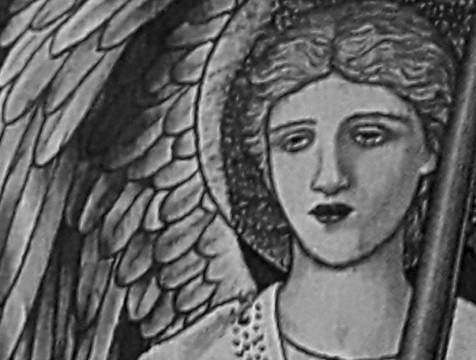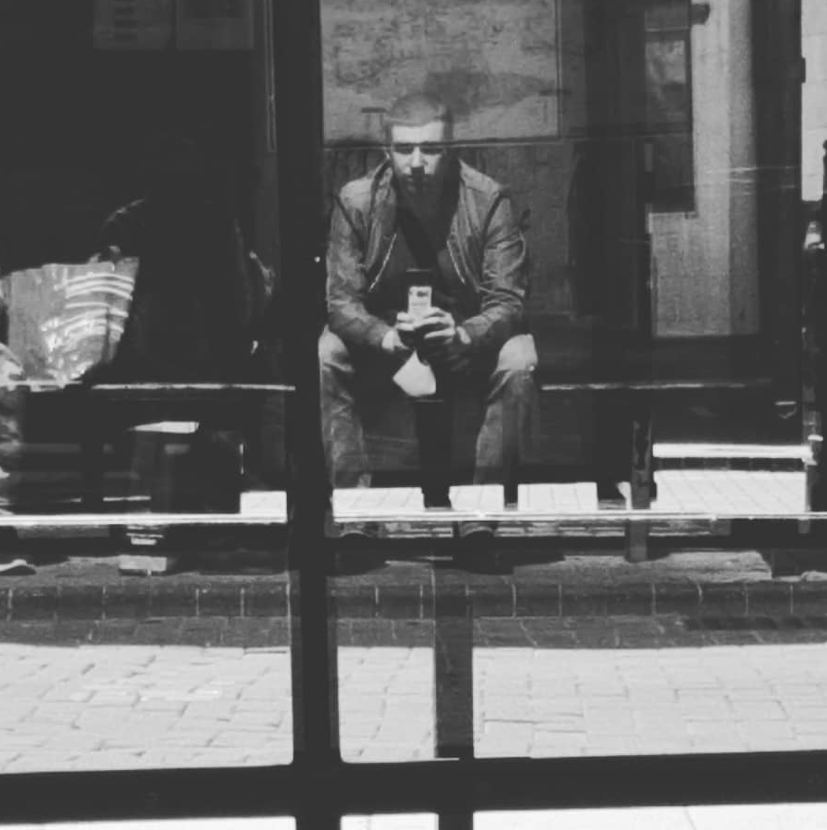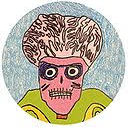- Kim Dorland
- Bob Bickford
- Alf Bogusky & Allan Harding MacKay
- Mr. Abbott
- Alana Solomon
- Scott Barry Kaufman
- LarchmontVanLonglunch
- Demi Potvin
- K. McLeod
- Sacha Gabriel
- Anonymous
- Isabella Di Sclafani
- Chris Robinson
- Chris Vaughan
- Donnez Cardoza
- Elizabeth Hodgson
- Lynn Crosbie
- Rachel Eagen
- Rebecca Blissett
- Jim Diorio
- The Galaxy Brains
- Gun Roze
- Carol Anne Gillis
- Kathryn McLeod
- Michael Murray
- Sarai Poirritt
- Peter Simpson
- Jane Wilson
- Rachel Sullivan
Warp & Weft
The Attainment
They huddled around the tapestry laid out on the metal tray, thinking about autopsies. Morris & Co.’s The Attainment: The Vision of the Holy Grail to Sir Galahad, Sir Bors and Sir Perceval had arrived back from Düsseldorf, where it’d been on display at a temporary exhibition bringing together German Nazarene painters and English Pre-Raphaelites. After unpacking and inspecting the tapestry, a conservationist hired by the owner said it wasn’t going to last another hundred and thirty years. Discolouration around the eyes of one angel couldn’t be ignored. More experts brought in to analyse new deterioration said invasive bugs might have got to work but no recent signs of white moth cocoons or any other tell-tale traces of pests were found. Treatment of the material wasn’t guaranteed to conserve the colour and texture (preserved well enough for more than a century!) although if they did nothing at all the rate of deterioration could easily accelerate. Staff at The Kunstsammlung Nordrhein-Westfalen said conditions in the packing crates and room itself were optimal. A conservator said he spoke to Düsseldorf thoroughly and agreed environmental factors were not to blame; they used correct flat storage, cushioned in acid-free tissue paper, so he argued some sort of instability like a mordant used in the distant past to fix the dye might be responsible.
A report made by the conservation specialist less than a year before being packed off to Düsseldorf said it was overall in excellent condition. Colours were still vivid, with little fading. Excellent had been underlined in the printout of the report museum staff received one morning. The specialist wrote signs of previous damage had been acceptably repaired by open couching to mimic the original weft and a note in the margin pointed to this sentence asking if it wasn’t possible to replicate this technique, which it wasn’t, they said, because of structural damage. At length the report listed every minor defect and described a history of museum quality procedures. Numerous white specks could be seen throughout, it said, which at the time of writing were not detrimental to the structure. This part had also been underlined. Small blue and brown stains in the right-hand section were mentioned and everyone involved busily identified each constellation of specks and stains. No mention in the report of the 4-4.5 cm bruise around the eye. Given the specialist’s meticulousness for the smallest soiling this could never have passed unnoticed.
Invasive bugs were finally ruled out. They looked through samples brought in for comparison by another textile specialist whose field of expertise was the preservation of fabrics typically much older. The textile specialist wasn’t shy about how little he thought of Morris & Co., referring constantly to superior originals, which he also took pains to announce he had seen and touched for himself in far-flung places , going into a long anecdote over lunch about some fourteenth century pieces in his possession recently acquired in Turkey. Next to any carpet by Ghyath ud-Din Jami (he said the name strangely from the back of his throat) Morris & Co. was Ikea. Then for a long time he told them about his last trip and found photos on his phone, all composed to avoid people, giving the impression he had Persepolis to himself. When he left later that day nobody was any surer what caused the decay or if any suitable conservation technique existed to stop it spreading. Or if it would spread. Or how long complete deterioration would take.

Every day they came back to deal with the deterioration, opened the doors into the restoration area (not unlike a mortuary), absolutely silent when they entered, fearing the 4-4.5 cm stain around the angel’s face had metastasized overnight. They would step into the partitioned part of the room, pull out the enamelled shelf and remove the acid-free tissue. Always relieved it seemed stable, measuring the same length and width. They were told drastic measures shouldn’t be ruled out but without agreeing on a proposed solution The Attainment: The Vision of the Holy Grail to Sir Galahad, Sir Bors and Sir Perceval still lays mummified in acid-free tissues on its enamelled metal shelf.
Crude and self-absorbed as the Morris & Co.-bashing expert was, something he said about Islamic patterns kept resurfacing in a junior conservationist’s head whenever she looked closely at the angel’s face. Talking about how distasteful he found the Pre-Raphaelites, he turned to his favourite subject: picture the Alhambra ceiling, he said. Now just imagine the miracle of that masterful craftsmanship and keep in mind they always saw fit to include imperfections, imperfections by design, he explained. Hidden within their beautiful cosmos are bum notes, affirming their station under God.
The stain perplexing every specialist does so because it has no earthly cause, she decided. William Morris’s final touch. Now when she sees the damage it’s not damage anymore, it’s a sign and thinking this way at least softens the blow.
The Vision
No photography allowed at the Instituto Carlos III.
Furniture pieces, wallpaper, textiles, jewellery, glasswork, metalwork, ceramics, books, paintings, drawings, engravings and even the same The Attainment: The Vision of the Holy Grail to Sir Galahad, Sir Bors and Sir Perceval tapestry I’d written about but never seen in the flesh arrived in Madrid three months ago and soon it’ll be going to Barcelona before travelling home.
When the building opens, I circulate the exhibition hunting for my subject. Precision is crucial and extends to my careful orbits around the exhibition. Nothing predetermines what my object of devotion for that day will be until it appears – tile, trestle table, bowl? Because there’s no photography allowed, I’m learning how to draw again. I draw until the early afternoon when more people start arriving to disrupt my absorption.
My hotel room is a sore counterpoint to Morris & Co. Giving voice to Morris’s dreariest predictions, every chair, table, textile, fragment of wallpaper and painting on display at the museum has a mauled double at Hotel Guzman. You could furnish Morris’s darkest nightmares with the beige blackout curtains, spotted carpet and sputum wallpaper. Softwood and lightweight foam have no illusions about the future of design and civilisation.
After a nap I go back to the exhibition until it closes. Bigger groups pass through at this time, obstructions with little time on their hands or clear expressions on their faces.
After they close, to retain for as long as possible a vision of the world furnished by Morris & Co. and not to fall into the miserable recesses of Hotel Guzman, I walk around the Salamanca District, follow the ruts of my routine down through Retiro Park to Atocha and take the metro back to Núñez de Balboa.
I’ve drawn chairs, stained-glass windows, brasses, tables, tiles, cabinets, copied patterns from a dozen textiles and prints (badly) as an elaborate tactic to avoid the tapestry. Paralysed by the massive reality of a vision finally seen up close, I can’t begin drawing it. Stunned by the privilege of proximity, I stand a few feet back and step closer and closer, unearthing new details, close enough to trace the buried warp and weft. Saúl the talkative museum guard says kindly not so close. I do this all morning, return in the evening to do the same, learning how to see again, every day and night until it’s time to leave for good.
The Holy Grail
Saúl has been a security guard at Instituto Carlos III for twelve years and says the sedate nature of his work gives him enough freedom not to mistake his life for a job. Allows him time in the evenings to sculpt, he says. Not worrying about money too much and being able to sculpt has been his greatest pleasure. No distractions, no noise interferes and he’s long given up on the idea of moving from his apartment in San Sebastian de los Reyes (enshrined by major branches of IKEA, Media Markt, Carrefour and giant shopping plazas) into the heart of Madrid. No, says Saúl, who has taken to chatting with me in the evenings when it’s quiet, irritating me at first, until I stopped drawing and started enjoying listening to him talk about art and his life with all its minor abnegations and scenic details, now he devotes himself to sculpting with no thought beyond making what he feels helpless to create. Until two or three in the morning chiseling, molding, modelling, tearing, with many different materials, in his studio, intended as a bedroom which he spent a long time adapting, even expanding it by knocking down a wall into a second bedroom, soundproofing, whitewashing, so it could hold his bulky works which so often in the past had to be broken down just to make space for new work. Saúl says in his twelve years working at the Instituto Carlos III nothing very strange happened until Morris & Co. arrived. He’s never had to do more than ask people not to stand too close, don’t touch, keep your voices down, not once asserting his authority in a way he’d never been very comfortable with anyway.
Just days after this exhibition opened, at about the same time in the evening he’s telling me this story – usually a quiet period – a man who’d not aroused Saúl’s slightest suspicion, took off his clothes and attempted to dismount the large tapestry and wrap it around himself. Being first on the scene, he tried talking calmly to the man, who repeated over and over again he was full of holes, couldn’t he see, he kept saying, couldn’t Saúl see right through him? He was full of fucking holes, more holes every day, he screamed, while Saúl restrained him from pulling the tapestry he’d managed to grab by a corner and wrestling the naked man, he thought if another guard hadn’t come that very second, given the man’s extraordinary will, he might easily have torn off a corner. Saúl and the other guard had him pinned to a wall when police arrived, still crying he was full of holes, cuffed and carted him off covered in a blanket, leaving his clothes on the floor, so it looked like he just dematerialised.
Saúl discovered it’s quite common for schizophrenics to believe they’re perforated. He told his sister about the incident. She’s a psychiatric occupational therapist. More than one patient she’d herself heard complain they had holes all over their bodies. One she remembers clearly, because on admission he seemed perfectly lucid. Easy to understand, untroubled, then one day he asks her what can he do about all the holes in his leg from getting any bigger? She couldn’t explain how it was this fantasy of being perforated connected to schizophrenia but was sure our man must have been schizophrenic.
Often Saúl finds himself thinking about how the man’s feeling. Imagine coming so close to literal wholeness. You touch the fabric of what will fill you up, Saúl says, only to be dragged down, pinned to the wall, carried away to a place where we can only imagine the walls are grey and the curtains and linen… Clinical, I say. Yes, he says, a sane spectrum. Imagine going back to that when you came so close! It makes him wonder if given the choice again, would he exert a little less force and he wonders too, watching gallery-goers passing The Attainment: The Vision of the Holy Grail to Sir Galahad, Sir Bors and Sir Perceval, if they ever get half the satisfaction the man would have got if he’d worn the tapestry. If Saúl had exerted less force, allowed him to grab enough material to cover his holes, who knows, maybe a miracle? says Saúl.

Chris Vaughan
